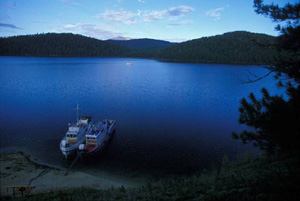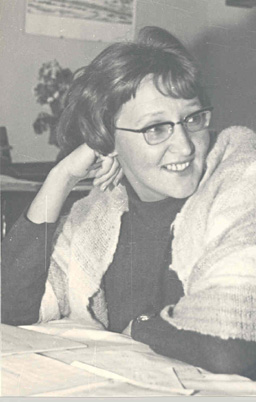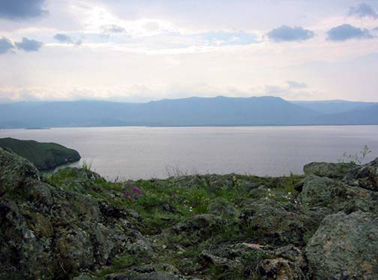Scientists Reveal Warming of World’s Largest Freshwater Lake
Study was made possible by three generations of a single family of Siberian researchers
| For
immediate release: April 30, 2008 |
Contact:
Arlie Corday, acorday@wellesley.edu |
WELLESLEY, Mass. – Russian and American scientists have demonstrated for the first time that the world’s largest lake, located in frigid Siberia, has warmed rapidly over the past half century, at a rate almost three times that of the average global air temperature. The findings are consistent with additional signs that this remote region is responding strongly to global warming.
A FAMILY AFFAIR: A childhood photo shows Lyubov Izmest’eva, co-author of the paper, with grandfather Dr. Mikhail Kozhov. Dr. Izmest’eva’s mother, Dr. Olga Kozhova, in photo below, continued the work begun by Professor Kozhov on Lake Baikal, and Dr. Izmest’eva currently maintains the long-term monitoring and research program on Lake Baikal at Irkutsk State University where her mother and grandfather also spent their careers.
Lake Baikal has seen significant warming, scientists have found |
Through long-term studies of Russia’s Lake Baikal, Stephanie Hampton, deputy director of the National Center for Ecological Analysis and Synthesis, and Marianne Moore, associate professor of biological sciences at Wellesley College, and four other scientists have written a research paper, “Sixty Years of Environmental Change in the World’s Largest Freshwater Lake,” which will appear in the scientific journal Global Change Biology.
 |
Lake Baikal, Siberia |
Using cutting-edge statistical analysis, the authors detail the effects of climate change in the world's largest lake – from warming of its vast waters to reorganization of its microscopic food web. “Warming of this isolated but enormous lake is a clear signal that climate change has affected even the most remote corners of our planet,” Hampton said.
GRAND DAME: Lake Baikal is the grand dame of lakes. In 1996, the United Nations Educational, Scientific and Cultural Organization (UNESCO) declared it a “World Heritage Site” because of its staggering biological diversity. It boasts more than 2,500 plant and animal species, most found nowhere else, including the world's only exclusively freshwater seal.
The lake actually contains 20 percent of the world's fresh water and could hold all of the water in the United States’ Great Lakes combined. It is the world’s deepest, most voluminous and oldest lake, at 25 million years old, which predates the emergence of humans. Yet it is a human connection that made this study possible.
“Our research relies on an unparalleled 60-year data set, collected in Lake Baikal by three generations of a single family of Siberian scientists,” Moore said. “In the 1940s, Professor Mikhail Kozhov began collecting and analyzing water samples in anticipation that this Great Lake could reveal much about how lakes function. Ultimately, his daughter Olga Kozhova attained a Ph.D. and a professorship at his university and continued the program, followed by her daughter, and our co-author, Lyubov’ Izmest'eva.”
DECADES OF WORK: The decades-long research effort even survived Stalin, who was infamous for his brutal treatment of scientists, as well as the fall of the Soviet Union and other social and financial upheavals in this region of the world. The data collection continued through every season, in an environment where winter temperatures drop to -50 degrees F.
The data on Lake Baikal reveal “significant warming of surface waters and long-term changes in the basal food web of the world’s largest, most ancient lake,” according to the researchers. “Increases in water temperature (1.21°C since 1946), chlorophyll a (300% since 1979) and an influential group of zooplankton grazers (335% since 1946) have important implications for nutrient cycling and food web dynamics.”
The scientists conclude that the lake now joins other large lakes, including Superior, Tanganyika and Tahoe, for which contemporary warming trends also exist.
“But temperature changes in Lake Baikal are particularly significant as an integrated signal of long-term regional warming, because this lake is expected to be among those most resistant to climate change due to its tremendous volume and unique water circulation,” they note.
The research paper is the result of a two-year collaboration involving six Siberian and American scientists who were assisted by student translators from Wellesley College.
“Two Wellesley students – now alums – were especially essential to the success of this international collaboration because of their superb translating skills at the working group meetings of my American and Siberian colleagues, funded by the National Center for Ecological Analysis and Synthesis,” Moore said. “These Wellesley alums are Cheryl Hojnowski and Adrien Smith, both Russian majors and recent recipients of Fulbright Fellowships to Russia, where they pursued environmental work.”
Moore also credits Professor of Russian Thomas Hodge, who co-teaches with her a Wellesley College course on the ecology and culture of the Lake Baikal region. The course, taught every other year, includes a month-long study of the lake on site in Siberia. Through their years of research, Moore and Hodge have established a professional relationship with local scientists.
“Through that effort, Tom and I met and interacted with Dr. Lyubov Izmest’eva, the owner of the data that my scientific colleagues and I analyzed in our manuscript,” Moore said.
In addition to Hampton and Moore, the paper’s contributors are Izmest’eva, director of the Scientific Research Institute of Biology, Irkutsk State University, Irkutsk, Russia; Stephen L. Katz, recently of the Northwest Fisheries Science Center, NOAA Fisheries, Seattle, Wash.; Brian Dennis of the Departments of Statistics and Fish and Wildlife Resources, University of Idaho, Moscow, Idaho; and Eugene A. Silow of the Scientific Research Institute of Biology, Irkutsk State University, Irkutsk, Russia.
For more information, contact Hampton at 805-892-2505 or hampton@nceas.ucsb.edu; Moore at 781-283-3098 or 508-651-2557 or mmoore@wellesley.edu; and Izmest'eva at 7 (395) 2243077 or root@bio.isu.runnet.ru. To read an abstract and proof of the Global Change Biology journal article online, click here.
Since 1875, Wellesley College has been a leader in providing an excellent liberal arts education for women who will make a difference in the world. Its 500-acre campus near Boston is home to 2,300 undergraduate students from all 50 states and 68 countries.
###



